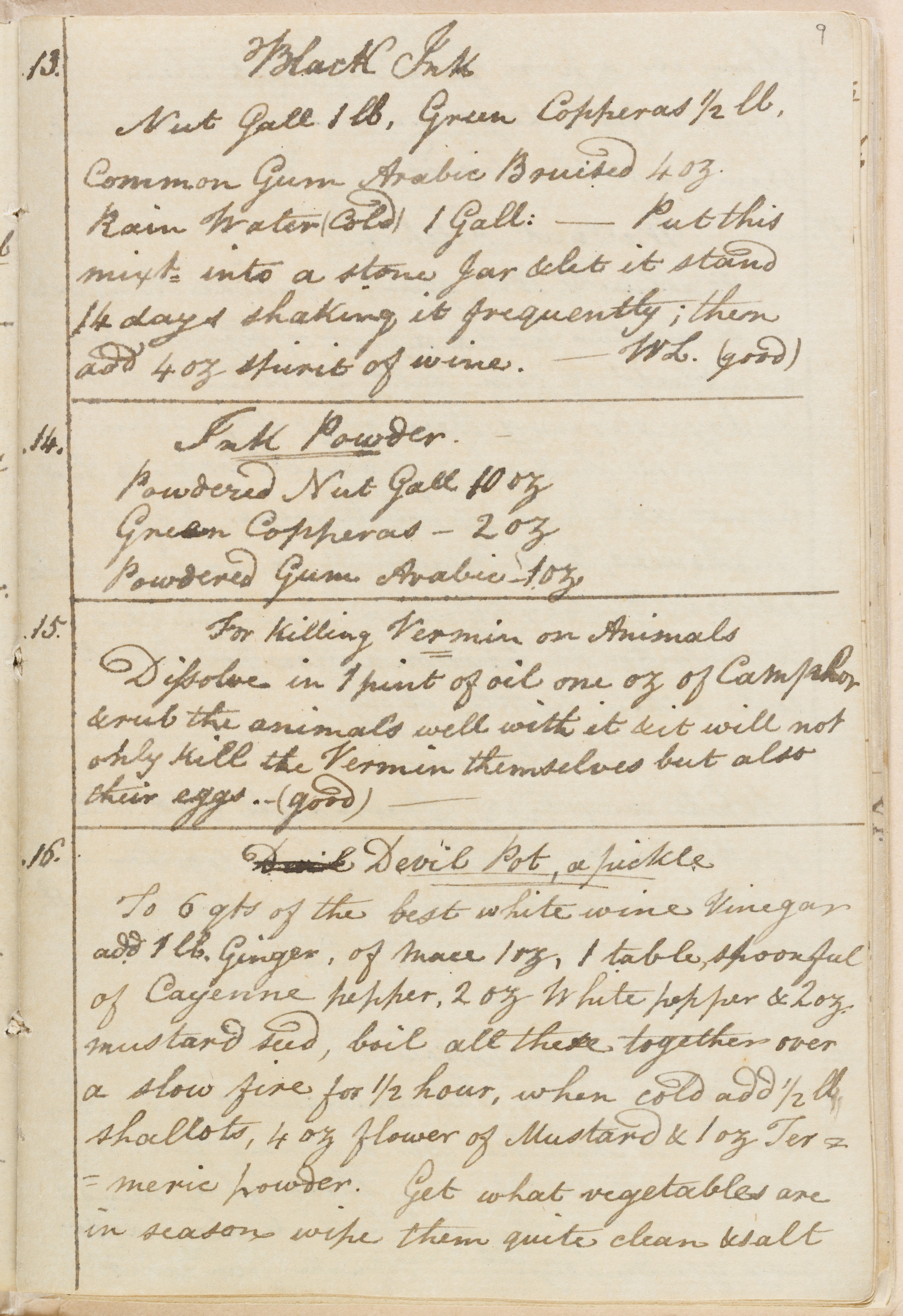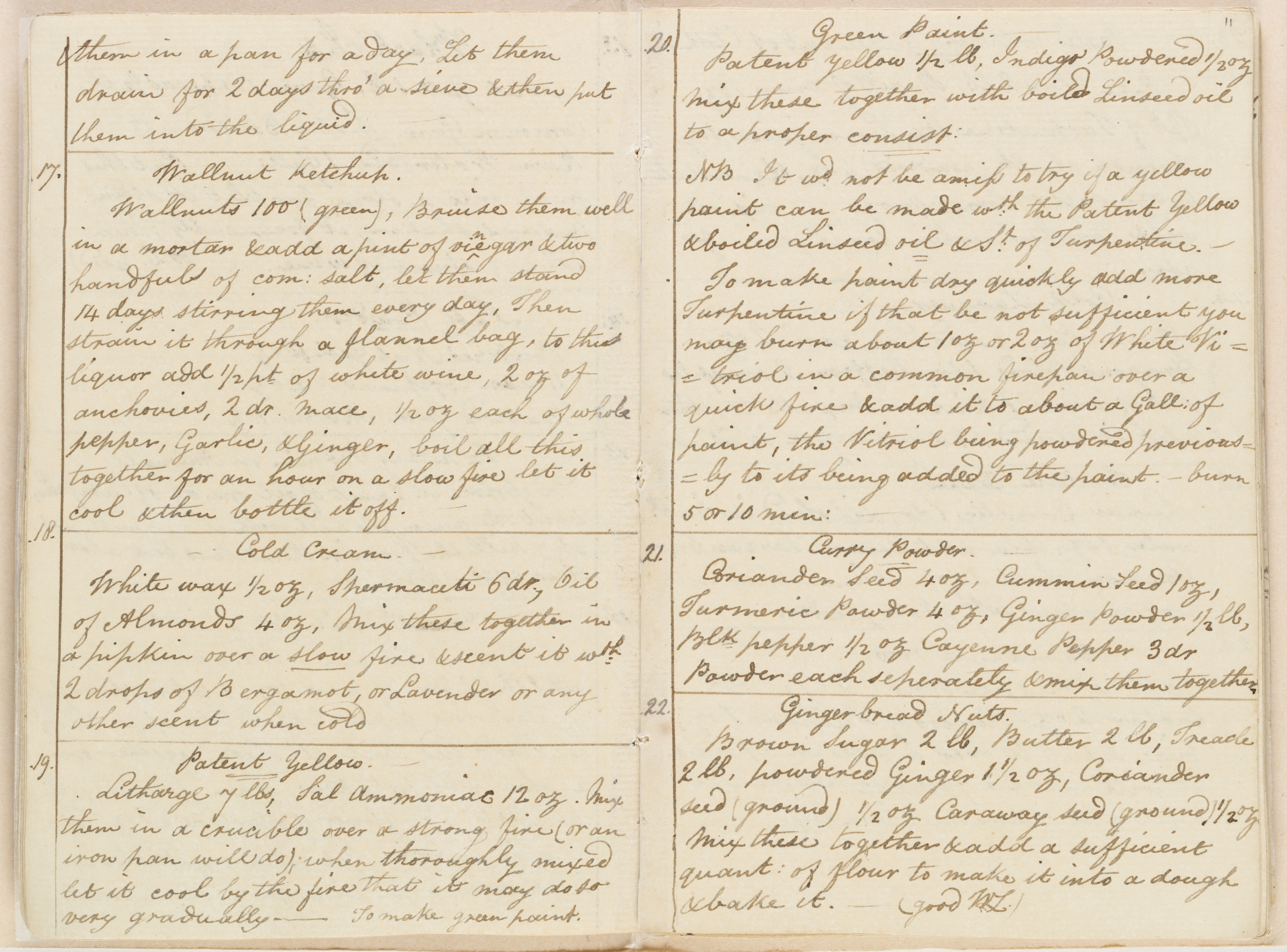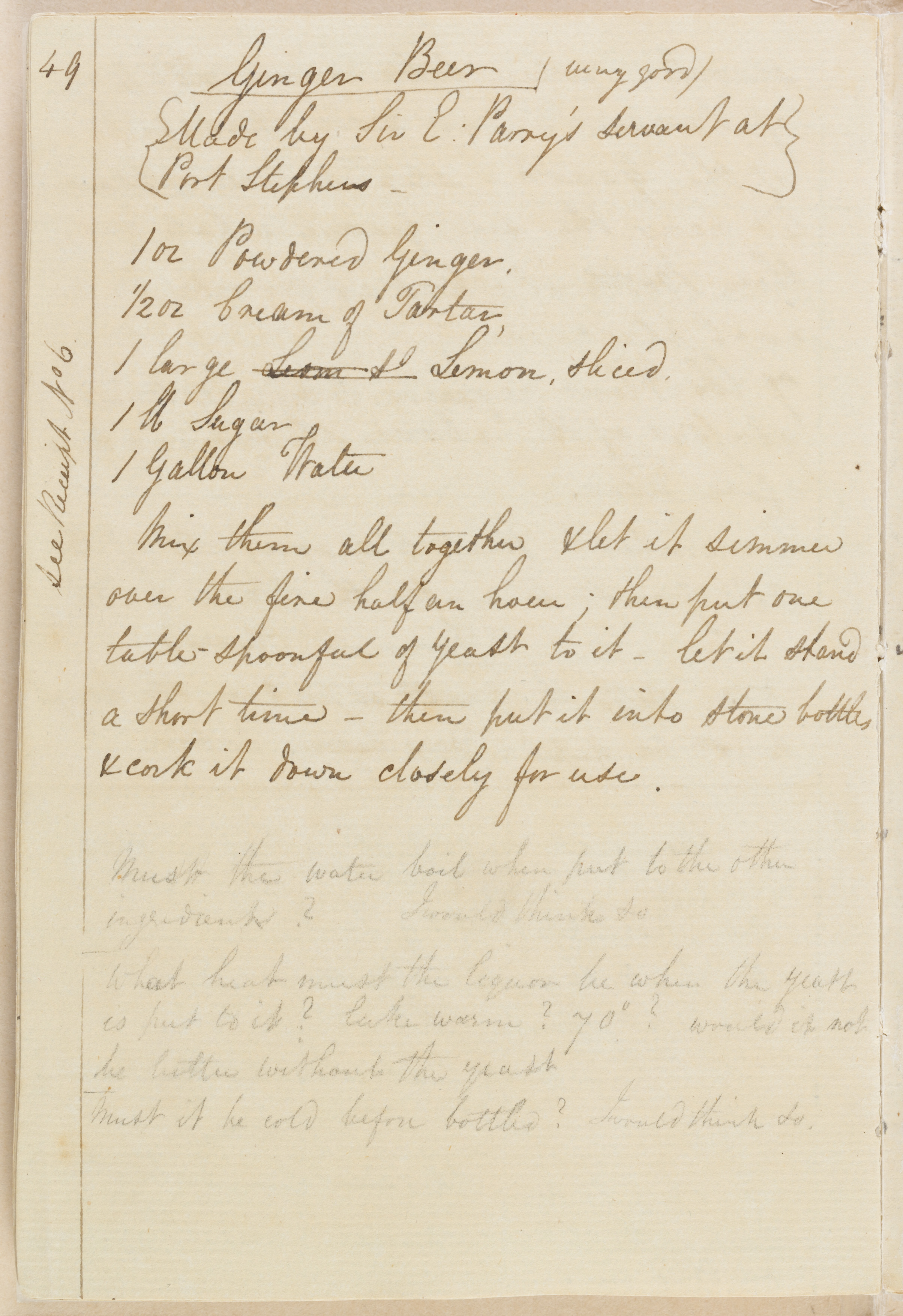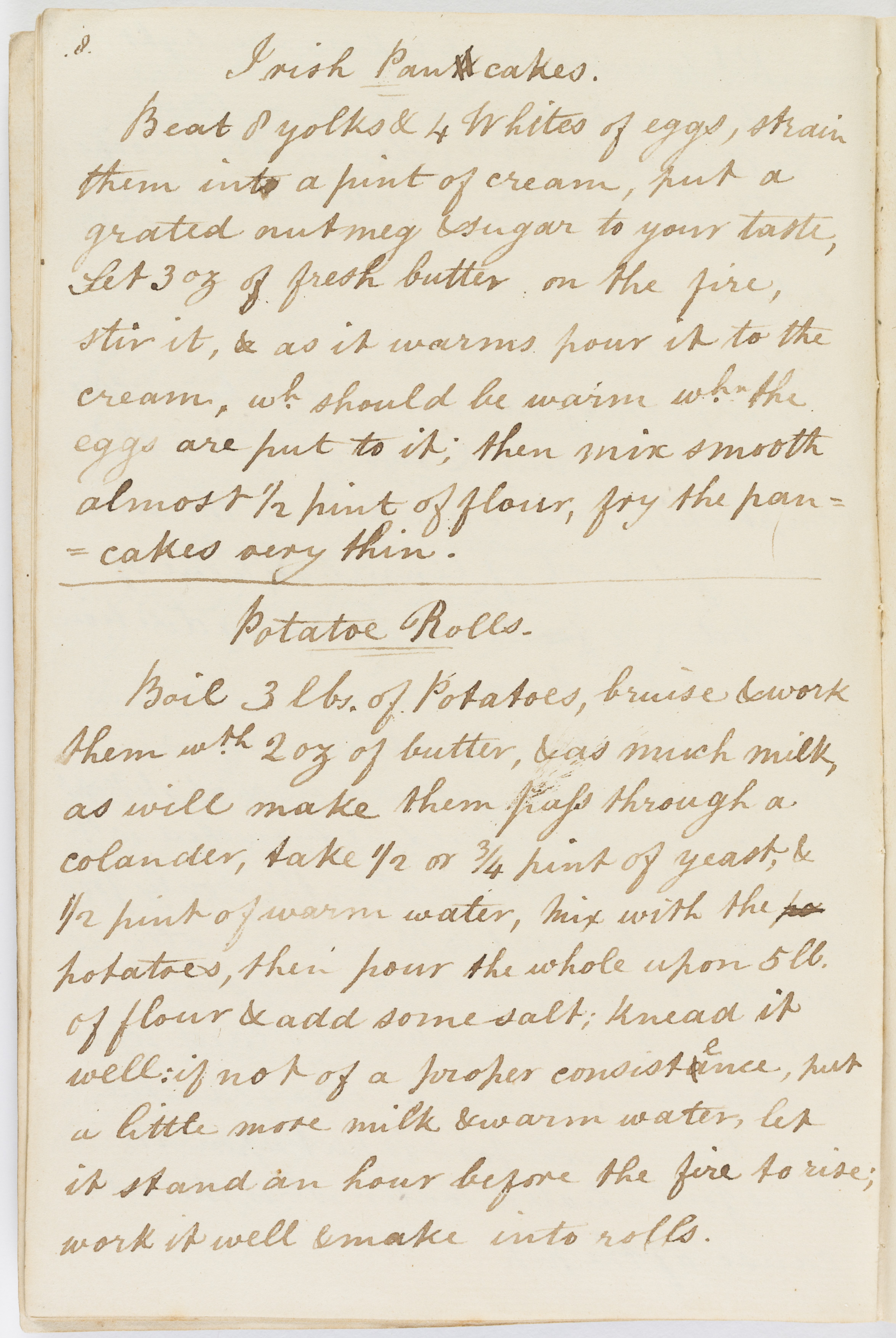Robert Scott, 1820, attributed to Miss Sharpe, MIN 354
FL1705449
By Mark Dunn
Tucked away among the vast collection of papers belonging to the Scott family of Glendon are four notebooks or ‘receipt’ books full of exotic recipes and remedies. Compiled by Helenus Scott Jnr in preparation for his new life in New South Wales, these small books — written in fine copperplate, with sturdy covers, dog-eared edges and numbered pages — offer a glimpse into the everyday living of emigrant farmers arriving in the colony in the 1820s.
Helenus Scott and his older brother Robert have been the focus of my research for the 2016 CH Currey Fellowship. The brothers — whose descendants include feminist Rose Scott, Library benefactor David Scott Mitchell, and the artist sisters Helena and Harriet Scott — are endlessly fascinating for a historian of colonial New South Wales.
Arriving in 1821, the Scott brothers were among the first wave of new immigrants to take up land in the recently opened Hunter Valley. After the years of Governor Macquarie, a new era of land settlement was about to transform the rural landscape, with wealthy settlers taking up increasingly larger holdings; more sheep and cattle followed close behind. The brothers had left England with their father, Helenus Snr, in 1821 to take advantage of this new model. But the death of Helenus Snr on the way at Cape Town threw their plans into disarray.
Despite their loss, Robert, just 20, and Helenus Jnr, only 18, decided to continue to New South Wales, where they received adjoining grants of land in the Hunter Valley, near Patricks Plains (now Singleton), which they combined into one. They named their new farm Glendon and went on to establish a large horse breeding stud, design houses and outbuildings for themselves and their neighbours, and play politics on a volatile frontier.
The Scott papers in the Mitchell Library are full of letters in and out, land deals and transactions, close observations of colonial politics and hints at a darker involvement in the violence along the Hunter Valley frontier. They provide a wealth of information on almost every conceivable colonial topic, whether it’s the horse breeding industry, the running of a rural estate, experimentation in cropping and farm techniques, law and order, or family life.
Although the two brothers lived together at Glendon, they followed slightly different paths. Robert played hard. Appointed as a magistrate in 1824, he led the hunt for bushrangers, runaway convicts and reprisal raids on Aboriginal groups. His ambition saw him become a prominent figure in the region and a well-known member of Sydney society, with plenty of parties attended, acquaintances made and meetings held.
As Robert wrote to his mother in 1822, he saw his prospects as ‘very flattering’, and was confident that, as many men in the colony who started with nothing had risen to great opulence on credit, with his capital he was sure to succeed.
The younger brother, Helenus, on the other hand, appeared more interested in the successful operation of the estate and in family life. From his earliest letters home to his mother, Helenus outlined the day-to-day operations at Glendon, how their crops were growing, the progression of the building of their first cottage, the practicalities of securing convict and free labour, and the particulars of their various neighbours.
Helenus’ receipt books, as he labelled them, are in fact more like recipe books. The first, bound in an orange marbled cover, begins on 10 November 1818, a full three years before the voyage. It starts its life as an exercise book, with wide-ruled rows filled with rote learning, phrases repeated down the page such as ‘Keep from inventing or copying whimsical’ or ‘Freedom and accuracy constitute good writing’; cross-hatched over the top are the words of ‘Auld Land Syne’ and Robert Bruce’s ‘Address to his Army’, reflecting his Scottish ancestry.
But turn the notebook over and start at the other end, and the preparations for his voyage become more obvious. A handwritten index card affixed to the front page lists 42 tips any young man might need when planning to settle in New South Wales. The first, taken from Richard Badham Thornhill’s The Shooting Directory (1804), includes hints on breeding dogs, breaking in pointers and setters, packing grouse and other birds (‘To preserve woodcock, bore a hole into a fir plank & stick their beaks in it, they will keep so for a quarter of a year’), and dealing with distemper or mange, or with dogs who have sore ears or sore feet or have been ‘bitten by a venomous thing’.
As the book progresses, the topics broaden into waterproofing boots, cleaning saddles and protecting gun barrels from rust, and then onto keeping linen white, polishing a mahogany table, and cleaning oil from feathers. Following are handy hints on accelerating the growing of corn and carrots, how to extract oil from poppy seeds and, most importantly, the making of ginger wine.
The second book begins in January 1822, a few short months after their arrival in Sydney and just prior to heading to the Hunter Valley to select their land. Here, Helenus continues with another 56 new tips for frontier living. There is no apparent thematic order, rather the tips are written as they are encountered. ‘Recipes for Irish Pancakes and Potatoe Rolls’ share the page with a method to make Roman cement or to fix broken china.
A good paste for chapped hands can be made with one quarter pound of washed, unsalted hog’s lard, mixed with rose water, the yolks of two new laid eggs and a large spoonful of honey, combined with oatmeal. Rounding out the volume are a finely drawn ink sketch of a mortar mill — with each part carefully labelled and a working description — and another of a cross-section of a pond with instructions on how to build it.
The third volume begins in April 1822, giving a good sense of the amount of information Helenus was gathering before ventures into the bush. Another 57 entries includes cold cream, which requires for six drops of spermaceti oil* — a not so subtle reminder of the whaling industry and its place in everyday colonial Sydney:
Cold Cream
White wax 1/2 oz, Spermaceti 6 dr, Oil of Almonds 4oz, Mix these together in a pipkin over a slow fire & scent it with 2 drops of Bergamot or Lavender or any other scent when cold.

Helenus Scott personal papers: Recipe notebook: Black Ink Item 3, No.13, pg 9

Helenus Scott personal papers: Recipe notebook

Helenus Scott personal papers: Recipe notebook: Ginger Beer Item 3, no.49, pg 20

Helenus Scott personal papers: Recipe notebook
In contrast to the first two books, volume three is added to for the next 22 years, the last item being taken from the Sydney Herald in 1844. This book also begins to display Helenus’ learning from friends and neighbours, with some recipes attributed to specific people: Mr Druitt’s blackening for harnesses and Thomas Johnson’s dye for the same ‘not equal to the last’; Mr Lanyon’s syrup to drink with water, or Mrs Fennell’s beer.
Perhaps most intriguing of all is this ‘very good’ ginger beer, as made by Sir E Parry’s servant at Port Stephens:
Ginger Beer {Made by Sir E Parry’s servant at Port Stephens} Very good!
1oz powdered ginger; ½ oz cream of tartare; 1 large lemon, sliced; 1lb sugar; 1 gallon water. Mix them all together and let them simmer over the fire half an hour; then put one table spoonful of yeast to it – then let it stand a short time –then put it into stone bottles, & cork it down closely for use.
Between 1830 and 1834, Edward Parry was the Commissioner in charge of the Australian Agricultural Company’s million acre holdings at Port Stephens, a good day or more’s ride from Glendon. From Helenus’ other correspondence, both personal and official, it is clear he had little time for convicts and servants, so the ginger beer must have been very good indeed.
My own convict ancestor, Phillip Kelly, who arrived in New South Wales in 1834, was assigned to Glendon where he worked as a shepherd. I can’t help but wonder, did he ever get to sip that very good ginger beer?
Dr Mark Dunn was the CH Currey Fellow at the Library for 2016. His fellowship Civilised or Savage? examined the entangled history of the Scott brothers’ interactions with Aboriginal people in the Hunter region.
*If you’re wondering where you can buy six drops of spermaceti these days, the answer is nowhere. But the Scotts may have bought theirs at John White’s Blazing Star, manufacturing and selling sperm oil at 79 George Street.
An eccentric French nobleman, a letter about Cook’s Endeavour voyage and an enduring bibliographic mystery come together in the Library’s Banks collection.
Australia played an important role in Charles Darwin’s theory of evolution.
Charles Dickens saw Australia as a utopia for the working class — and his wayward sons.
A Library fellowship uncovered an archive of emotion in the correspondence of Henry Parkes and Thomas Woolner.